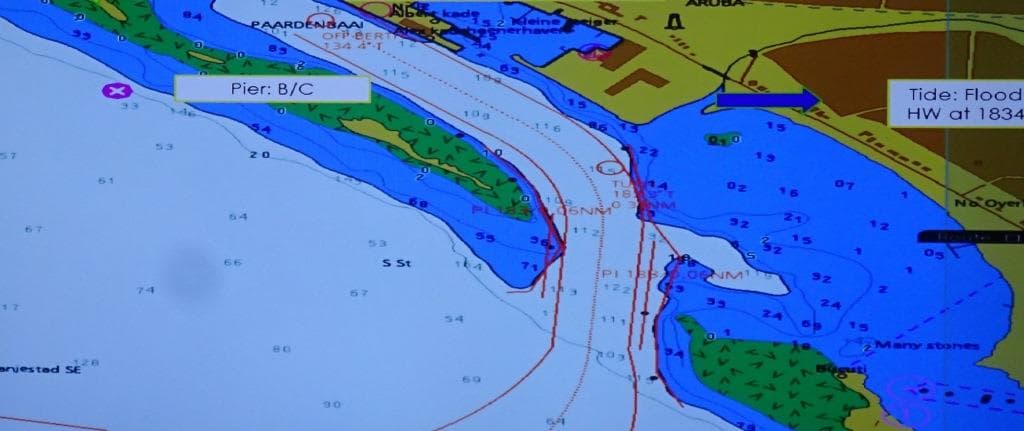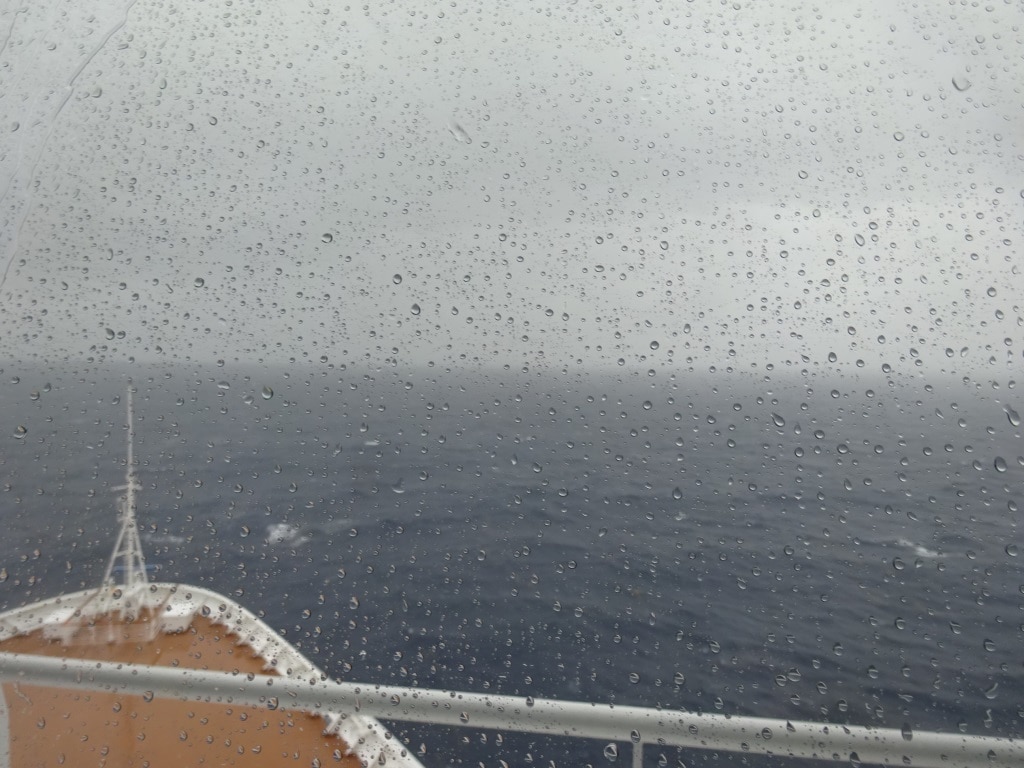This morning between 0400 and 0700 hrs. we zig-zagged through the Windward Passage and into the Caribbean Sea. To do this we first hugged the East coast of Cuba, staying close to the Light house of Cabo Maisi and once out of the Vessel Traffic Separation Scheme we came closer to the West coast of Hispaniola. Hispaniola is the name of the whole island to the right of Cuba and it is split in two halves. One is Haiti the other is the Dominican Republic. Thus we saw the sun rise over the mountain range of Haiti on our port side. A bit of a watery sunrise as there were only a few rays and then it clouded in again. From then on the clouds got thicker and thicker and by 10 am. we had a few torrential rain showers coming over the ship. By noon that had tapered off to the occasional drop of rain but it took the remainder of the day to leave the weather front behind. Or better said the weather front to drift away from our course line as we are on a south south easterly course towards Aruba.
Although most of the navigators have been to Oranjestad many a time, there is still a very in depth voyage and arrival meeting the day before. Being Dutch we do this at Coffee time at 10 am. in the morning. This time the affair was enriched by Dutch Cookies which had been brought over from Holland by a new joiner. We have all sorts of cookies on board but not always the brand that is considered best by the experts. (That’s us) The whole officer team assembles including the Security Officer (in charge of the gangway setup) and then the arrival is simulated on a big TV screen step by step. Docking plans are discussed – where the ropes go- and the navigation officer has made a cheat sheet for forward and aft mooring stations with photos from last time, so we can achieve the optimum mooring line configuration.

The approach into Oranjestads harbor, the “Paardenbaai”. As long as we stay between the red lines and do not hit the blue bump, we are in good shape.
Then the most important part is the approach to the dock, with the focus on what if. If you drive a car into a garage, you focus on that. We worry about the fact if the garage door might come down while we are driving in and what do we need to do to have –positive confirmation –so that will not happen. Maybe cynical but it saves paint scratches on the cars and lives on ships. Thus “Plan B” is very important. For Aruba there are two challenges: One, when you sail in, you cannot stop anymore or drop anchor. It is too narrow. B. There is always a lot of wind which pushes you away from the dock. Luckily the port has a natural plan B. There is an exit at the end of the harbor, so if the ship comes in and if you do not like the situation you just sail out again. I have done that once in my career, 14 years ago, when a sightseeing catamaran decided to sail westward between the pier and the ship, while I was coming in and was executing a maneuver to reduce the wind influence which was gusting up to 30 knots. I could not slow down, the ship would have been set towards to reef to the south and I could not turn around so I just gave full ahead, sailed out, turned back to the West entrance and made a new approach. It was quite enlightening to listen to the pilot who questioned the legitimacy of the boat skippers heritage, and that of his immediate family, fluently in three different languages. (English, Dutch and Local) After docking successfully the second time, I explained to the guests what had happened and asked those who were going on that tour boat to voice my displeasure. Which they did with great gusto. The tour boat skipper never made that mistake again.

The exit of the “Paardenbaai” giving the option to sail out if you do not like the situation. (Both photos are screen captures of the actual ships voyage plan.)
Tomorrow should be an average day according to our prognoses; winds of up to 20 knots, sunny but with a chance of showers, so the ship will put out a few extra lines to deal with wind gusts which might be hidden inside the showers. According to the agent we are the only ship in port but according to the Aruba port authority there are two more. The Norwegian Dawn and the Freewinds. Tomorrow we will find out who was correct.


November 11, 2017 at 7:39 pm
The pilot’s “local” language discourse would have been in Papiamento, the local language….Ruud